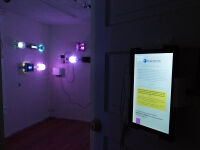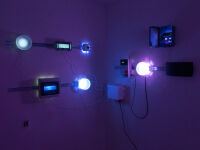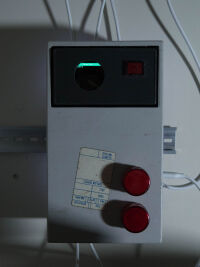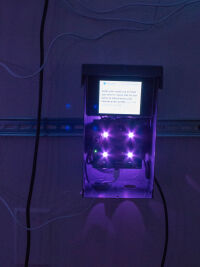Introduction
In Maelstrom, viewers get to experience their personal data being shared among 30+ machines created by the artist and set in vintages like the 1980s and late ’90s. The machines spread rumors about the visitors to each other throughout the installation–which is designed to feel like you’re at the center of a social media conspiracy theory.
By comparing marketing techniques to the connection-forming tendencies of conspiracy theorists, Maelstrom invokes the unexpected ramifications of small user actions in a brokerage-fueled information economy, and alludes to the wider implications of being a connected citizen when real-world governments and corporations have deployed widespread, surveillance-based tracking systems.
Maelstrom was supported by the DC Commission on the Arts and Humanities, grant number FY21 AHFP-07741, and the Derek Lieu Residency Program at HOLE IN THE SKY DC.
What is it?
It only takes a weak signal to get segmented. Have you ever looked at, say, a part for a toilet on some online bookseller’s website and had it follow you around the internet for a week? This is made possible by a dizzying array of “retargeting” companies and networks who have a very strong incentive to label you with a category, or segment, and a much weaker incentive to un-label you. Who says how long these labels last?
Honestly, the toilet parts are just the tip of the iceberg. It’s not that hard for me to imagine a world where looking at a recipe for pot brownies affects your applicant score in a company’s H.R. system, or keeps you from getting a mortgage, or parole. And I’m not talking about countries with a government firewall, or some kind of federal surveillance—this is all enabled by good old-fashioned cross-border commerce. The accidental spread of data—a single tap on a link turning into ads, or a black mark on your record—is going to be a problem.
In the installation “Maelstrom,” viewers get to experience their personal data being shared among 35 machines created by the artist and set in multiple vintages, such as the ’80s and mid-‘90s. The machines spread rumors about the visitors to each other throughout the installation—which is designed to feel like you’re at the center of a social media conspiracy theory.
The data is both observed from mobile devices—using wireless monitoring methods currently employed by governments and businesses—and collected from willing visitors by prompts on the devices. Visitors may choose to join a Wi-Fi network to provide additional information that is spread among the machines, like a game of “Telephone.” No visitor data is retained for longer than 15 minutes. But it could be.
The machines themselves are created in appearances from several different time periods, and are set within the overall frame story of being a data management platform’s corporate museum. They were made with a mix of found objects, bespoke 3D-printed designs, commercial modules, and circuit boards designed by the artist.
By comparing marketing techniques to the connection-forming tendencies of conspiracy theorists, Maelstrom invokes the unexpected ramifications of small user actions in a brokerage-fueled information economy, and alludes to the wider implications of being a connected citizen when real-world governments and corporations have deployed widespread, surveillance-based tracking systems.
– Chris Combs
Past exhibitions
“Maelstrom” was at Rhizome DC from January 16–February 14, 2021.
Press
- Hackster.io: "This Surreal Art Installation Lampoons Our Lack of Privacy in the Internet Age" (January 29, 2021)
- Washington Post: "In the galleries: Where nature and technology’s detritus collide" (January 29, 2021)
- The DC Line: "The DC Lineup for this weekend: a cappella, civil rights history and comic relief" (January 15, 2021)










